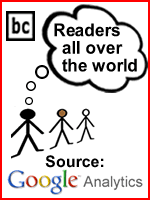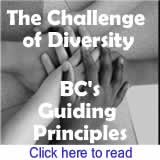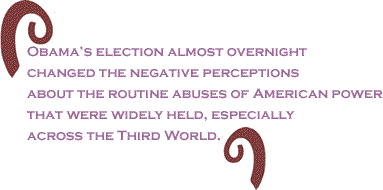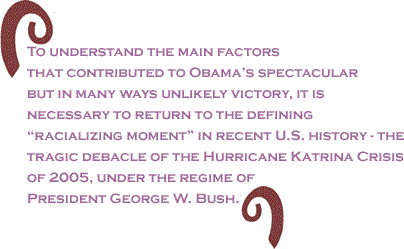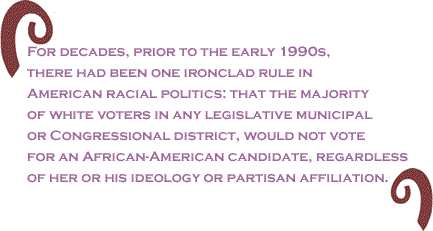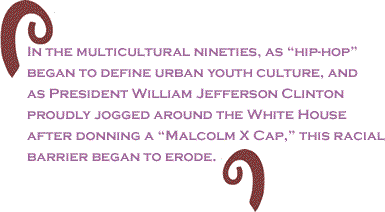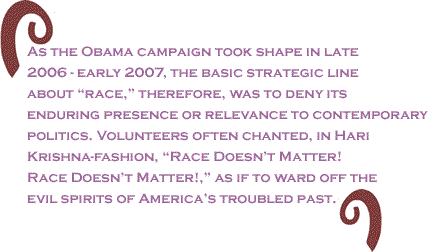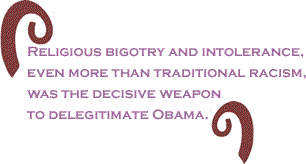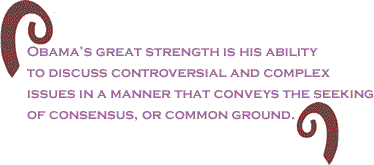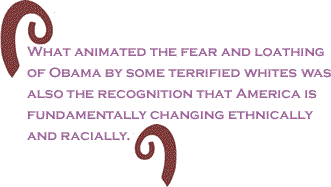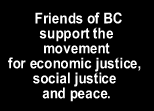
|
|||||||||||||||||||||||
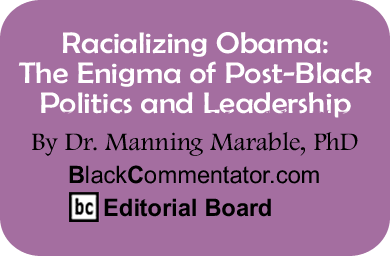
|
|

Custom Search
|
|
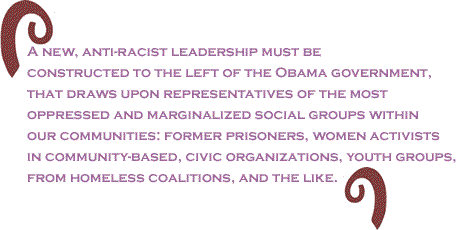 |
|
I The historical significance of the election of Illinois Senator Barack Obama as president of the United States was recognized literally by the entire world. For a nation that had, only a half century earlier, refused to enforce the voting rights and constitutional liberties of people of African descent, to elevate a black American as its chief executive, was a stunning reversal of history. On the night of his electoral victory, spontaneous crowds of joyful celebrants rushed into streets, parks and public establishments, in thousands of venues across the country. In Harlem, over ten thousand people surrounded the Adam Clayton Powell State Office Building, cheering and crying in disbelief. To many, the impressive margin of Obama’s popular vote victory suggested the possibility that the United States had entered at long last an age of post-racial politics, in which leadership and major public policy debates would not be distorted by factors of race and ethnicity. Obama’s election almost overnight changed the negative perceptions about the routine abuses of American power that were widely held, especially across the Third World. One vivid example of the recognition of this new reality was represented by a petulant statement by Ayman al-Zawahri, the deputy leader of the Al Qaeda terrorist network. Al-Zawahri contemptuously dismissed Obama as only the “new face of America,” which only “masked a heart full of hate.” Al Qaeda also released a video in which former Bush Secretaries of State Colin Powell and Condoleezza Rice, both African Americans, as well as Obama, were denigrated “[in] the words of Malcolm X (may Allah have mercy on him) [as] ‘house Negroes’.” Malcolm X was favorably quoted for condemning the docile “house Negro who always looked out for his master.” To Al Qaeda, Obama was nothing short of a “hypocrite and traitor to his race.” American “continues to be the same as ever ….” [1] Despite Obama’s concerted efforts to present himself as a presidential candidate “who happened to be black,” both proponents and enemies like al Qaeda were quick to freeze his identity to the reality of his blackness, for both positive and negative reasons. To understand the main factors that contributed to Obama’s spectacular but in many ways unlikely victory, it is necessary to return to the defining “racializing moment” in recent U.S. history - the tragic debacle of the Hurricane Katrina Crisis of 2005, under the regime of President George W. Bush. It was not simply the deaths of over one thousand Americans, and the forced relocations of hundreds of thousands of people from their homes in New Orleans and across the Gulf of Mexico states-region who were disproportionately black and poor. The inevitable consequences of a natural disaster in New Orleans, a city below sea level, were not unexpected. Rather, it was the callous and contemptuous actions of the federal government - especially the Federal Emergency Management Agency (FEMA), plagued by cronyism and corruption, that directly contributed to blacks’ deaths. The world witnessed on television for days the stunning spectra of thousands of mostly black and poor people stranded in New Orleans’ downtown Morial Convention Center, which FEMA’s vehicles claimed it was impossible to send in medical supplies, food, and fresh water, while media representatives and entertainers easily were able to drive to the center. States like Florida, that proposed to send in five hundred airboats to assist with Gulf Coast rescue efforts were inexplicably turned away. Needed supplies such as electric generators, trailers and freight cars stocked with food went undelivered to starving, desperate evacuees. The overwhelming collage of tragic images pointed to the enduring blight of racism and poverty as central themes within the arrangements of institutional power within the United States. [2] By mid-September, 2005, sixty percent of all African Americans surveyed were convinced that “the federal government’s delay in helping the victims in New Orleans was because the victims were black.” What was striking to minorities was that the overwhelming majority of white citizens remained convinced that their government was color-blind: only 12 percent of whites surveyed agreed that the government’s Katrina response was racially-biased. [3]
The reality of racial injustice through governmental inaction was also reinforced among millions of black Americans by the results of the presidential elections of 2000 and 2004, both won by Republican George W. Bush. In 2000, there was substantial evidence that tens of thousands of African-American voters in Florida were deliberately excluded from exercising the franchise, through a variety of measures. Thousands of Florida voters with misdemeanor convictions, for example, were illegally barred from voting. Thousands of black voters in specific districts were inexplicably barred from casting ballots. Four years later, a similar process of black voter suppression occurred in Ohio, which Bush narrowly won over Democratic presidential candidate John Kerry. [4] To many African Americans the two controversial presidential elections and the Katrina tragedy cemented the perspective that the American system was hardwired to discriminate against the interests of people of African descent. If basic political change was possible, or even conceivable, it would probably not be through frontal assaults, similar to the bold challenges of Jesse Jackson’s Rainbow Coalition presidential campaigns of 1984 and 1988. If meaningful change occurred at all, it would probably happen at the margins. Few anticipated the possibility that an African-American candidate, with relatively little experience at the national level, could capture the Democratic Party’s presidential nomination, much less win election to the presidency. II. Although the overall character of national black politics was in many respects defensive and deeply pessimistic, a growing minority trend within African-American leadership perceived the early years of the twenty-first century quite differently. For decades, prior to the early 1990s, there had been one ironclad rule in American racial politics: that the majority of white voters in any legislative municipal or Congressional district, would not vote for an African-American candidate, regardless of her or his ideology or partisan affiliation. There was an omnipresent glass ceiling in electoral politics limiting the rise of all black elected officials. Blacks could be elected to Congress or as mayors of major cities only if districts held high concentrations of minority voters. In the 1980s, progressive black candidates such as Harold Washington sought to circumvent this racial barrier by constructing multiracial coalitions as the base of their electoral mobilizations, reaching out to traditional liberal constituencies. [5] Other more conservative African-American leaders, such as Thomas Bradley who had been elected mayor of Los Angeles on his second try in 1972, and Philadelphia mayor Wilson Goode in the 1980s, won whites’ support by deliberately downplaying their own ethnic affiliations and racial identities. They espoused a pragmatic, non-ideological politics that catered to local corporate interests and promoted urban concessions, even these moderate black officials could not depend on the electoral support of many whites, even in their own parties. Political scientists first began observing the lack of reliability of pre-election polls for whites in races involving African-American candidates nearly three decades ago. In the 1982 California gubernatorial election, pre-election polls indicated that Democratic Los Angeles Mayor Thomas Bradley would easily defeat Republican challenge George Deukmejian. After Bradley narrowly lost to Deukmejian, it became evident that a significant percentage of whites who had been predicted to support Bradley had voted for the Republican. [6] This so-called “Bradley effect” was subsequently documented in dozens of elections. For example, in 1989, Virginia Lieutenant Governor Douglas Wilder, a Democrat, announced his candidacy for the state’s governorship. In many ways Wilder ran a campaign similar to that of Obama, two decades later. Wilder focused on issues large devoid of racial overtones, such as economic development, the environment and public health. Opinion polls in the state showed Wilder maintaining a double-digit lead over a lackluster Republican candidate, Marshall Coleman. In Virginia’s gubernatorial election, which Wilder managed to win but by less than one-half of one percent of the total vote, white voters overwhelmingly had favored Coleman. Even more significantly, pollsters found that many white Virginians deliberately provided false information when revealing their voting intentions in polls. When whites were questioned about their gubernatorial preferences by a white pollster, Coleman defeated Wilder by 16 percent. But when black pollsters were used for interviews, whites favored Wilder by 10 percent over Coleman. Both the inconsistent pre-election polling information by whites, and the actual election returns appear to validate the “Bradley effect.” [7]
The cases of Bradley and Wilder were in many ways mirrored by the 1989 mayoral election in New York City, which was won by an African-American Democrat, Manhattan Borough President David Dinkins. As noted by Andrew Kohul, the president of the Pew Research Center, the Gallup organization’s polling research on New York City’s voters in 1989 had indicated that Dinkins would defeat his Republican opponent, Rudolph Giuliani, by 15 percent. Instead, Dinkins only narrowly won by 2 percent. Kohul, who worked as a Gallup pollster in that election, concluded that “poorer, less well-educated [white] voters were less likely to answer our questions; “ so the poll didn’t have the opportunity to factor in their views. As Kohul observed: “Here’s the problem - these whites who do not respond to surveys tend to have more unfavorable view of blacks than respondents who do the interviews.” [8] In the multicultural nineties, as “hip-hop” began to define urban youth culture, and as President William Jefferson Clinton proudly jogged around the White House after donning a “Malcolm X Cap,” this racial barrier began to erode. A new generation of young African-American politicians - many of whom were lawyers, corporate executives, city administrators, educators, community organizers, and foundation officers - began seeking public office, first in municipal politics and then at statewide levels. With few exceptions, they rhetorically offered a race-neutral language to advocate the interests of their constituencies - who happened to be white and Latino as well as African-American, middle-class as well as working class, unemployed and poor, those without high school diplomas as well as those with professional and graduate degrees. Michael White, the mayor of Cleveland Ohio, in the 1990s, was in many ways the model for post-black mayoral politics. Although ethnically black and a nominal Democrat, White was far more comfortable discussing tax abatements and incentives to attract corporate investment to inner city Cleveland, than leading a public protest march through the city’s black neighborhood. By the twenty-first century, hundreds of race-neutral, pragmatic black officials had emerged, winning positions on city councils, state legislatures and in the House of Representatives. Frequently they distanced themselves from traditional liberal constituencies such as unions, promoted gentrification and corporate investment in poor urban neighborhoods, and favored funding charter schools as an alternative to the failures of public school systems. A growing share of these new leaders were elected from predominately white districts. In 2001, for example, according to the Joint Center for Political and Economic Studies, roughly 16 percent of the nation’s African-American state legislators, had won election in predominantly white districts. By 2008, out of 622 black state legislators nationally, 30 percent represented predominately white constituencies. Between 1998 and 2008, about two hundred African-Americans defeated whites for municipal and state legislative races, even in some states, such as Iowa, Minnesota and New Hampshire, where black populations are small. [9] In November 2006, civil rights attorney Duval Patrick, employing campaign strategies drawn from Barack Obama’s successful 2004 Senate bid, easily won the gubernatorial race in Massachusetts, a state with a 79 percent white population. [10] Ideologically,
this new leadership group reflected a range of divergent views
on social policy. The most prominent “moderates” within this cohort
included: former Tennessee Congressman Harold Ford, who is Obama undoubtedly took most of these factors into account - the possibility of a “Bradley/Wilder effect” on whites’ support of black candidates, African-American grievances surrounding the 2000 and 2004 presidential campaigns, the recent debacle of the Katrina Crisis, and the rise of the postracial politics of a new generation of black leaders - to construct his own image and political narrative essential for a presidential campaign. Early on in their deliberation process, the Obama pre-campaign group recognized that most white Americans would never vote for a black presidential candidate. However, they were convinced that most whites would embrace, and vote for, a remarkable, qualified presidential candidate who happened to be black. “Race” could be muted into an adjective, a qualifier of minimal consequence. So ethnically, Obama did not deny the reality of his African heritage; it was blended into the multicultural narrative of his uniquely “American story,” which also featured white grandparents from Kansas, a white mother who studied anthropology in Hawaii, and an Indonesian stepfather. Unlike black conservatives, Obama openly acknowledged his personal debt to the sacrifices made by martyrs and activists of the Civil Rights Movement. Yet he also spoke frequently about the need to move beyond the divisions of the sixties, to seek common ground, and a post-partisan politics of hope and reconciliation. As the Obama campaign took shape in late 2006 - early 2007, the basic strategic line about “race,” therefore, was to deny its enduring presence or relevance to contemporary politics. Volunteers often chanted, in Hari Krishna-fashion, “Race Doesn’t Matter! Race Doesn’t Matter!,” as if to ward off the evil spirits of America’s troubled past.
Obama’s strategic approach on race was indeed original, but coming at a time of hopelessness and pessimism among many African Americans, there were doubts that the young Illinois Senator could actually pull it off. To some, Obama’s multiracial pedigree raised questions about his loyalties to the cause of black people. Curiously, many of those with the loudest queries were African-American conservatives and Republicans, whose own bona fides on racial matters were often under fire. For example, conservative writer Debra Dickerson, author of The End of Blackness, declared in January, 2007, that “Obama would be the great black hope in the next presidential race, if he were actually black.” [11] Journalist Stanley Crouch took a similarly negative approach, arguing that while Obama “has experienced some light versions of typical racial stereotypes, he cannot claim those problems as his own - nor has he lived the life of a black American.” [12] Juan Williams, conservative commentator on FOX News, warned that “there are widespread questions whether this son of a white American mother and a black Kenyan father really understands the black American experience.” [13] As late as December, 2007, roughly one-half of all African Americans polled still favored Hillary Clinton over Obama as their Democratic presidential candidate. Some of Obama’s sharpest “racial doubters” were even from Chicago, his home base. Eddie Read, chair of Chicago’s Black Independent Political Organization, for example, predicted that “nothing’s going to happen” from the Democratic Senator’s candidacy, because “he doesn’t belong to us. He would not be the black president. He would be the multicultural president.” [14] Obama’s ultimate victory over Hilary Clinton in the 2008 Democratic primaries began with his implacable opposition to the U.S. invasion of Iraq. Back in 2002, Obama warned that “an invasion of Iraq without a clear rationale and without strong international support will only fan the flames of the Middle East, and encourage the worst, rather than the best, impulses of the Arab world, and strengthen the recruitment arm of al-Qaeda.” Less noticed in this speech was Obama’s appeal “to make sure our so-called allies in the Middle East, the Saudis and the Egyptians, stop oppressing dissent, and tolerating corruption and inequality, and mismanaging their economies so that their youth grow up without education, without prospects, without hope, the ready recruits of terrorist cells.” [15] Like Malcolm X a generation earlier, Barack Obama’s entry into national politics was associated with the Islamic world. Even before the announcement of his candidacy for president, media conservatives resorted to Islamophobia to denigrate Obama. For example, on CNN’s “Situation Room,” on 11 December 2006, correspondent Jeanne Moos observed darkly, “Only one little consonant differentiates” Obama versus Osama, also noting that the candidate’s middle name, Hussein, was shared with “a former dictator.” In early 2007, Bernard McQuirk, then the executive producer of the Don Imus Radio Show, declared on air that Obama has “a Jew-hating name.” Conservative radio commentator Russ Limbaugh repeatedly referred to the candidate as “Osama Obama.” [16] Religious bigotry and intolerance, even more than traditional racism, was the decisive weapon to delegitimate Obama. The 17 January 2007 issue of Insight magazine, for example, claimed that Obama “spent at least four years in a so-called madrassa, or Muslim seminary, in Indonesia.” Writing in the Chicago Sun-Times, columnist Mark Steyn then claimed that Obama “graduated from the Sword of the Infidel grade school in Jakarta.” [17] On FOX News, former liberal-turned-reactionary Juan Williams argued that Obama “comes from a father who was a Muslim and all that … Given that we’re at war with Muslim extremists, that presents a problem.” [18] The truth of Obama’s background was that his biological father, while being raised as a Muslim, was an atheist like Obama’s mother. Obama’s stepfather was not deeply religious. The two elementary schools Obama attended, one Catholic, the other predominately Muslim, were not madrassas. In 2007, CNN correspondent John Vause traveled to Indonesia, investigated the charges, and established the truth about Obama’s religious and family background. Yet despite this, the “madrassa myth” linking Obama to Islamic terrorist cells continued to be promoted on television and especially over the internet. [19]
As the Democratic caucuses and primaries began, however, Obama quickly established the ability to win a surprisingly large share of whites’ votes. He consistently won majorities among all voters under 30, voters earning over $50,000 annually, and college-educated voters. After the South Carolina Democratic primary, where Bill Clinton’s racially-insensitive remarks alienated thousands of voters, the African-American electorate swung decisively behind Obama. The most damaging controversy involving race to erupt during Obama’s quest for the Democratic presidential nomination involved the politics of faith: the media’s rebroadcasting of provocative statements by the candidate’s former minister, the Reverend Jeremiah Wright, of Chicago’s Trinity United Church of Christ. A major center for social justice ministry in Chicago, Trinity’s activist program was not unlike that of other progressive African-American churches involved in the Civil Rights Movement in the 1960s, or the anti-apartheid campaign against white South Africa during the 1980s. Yet even before the controversial videos of the Reverend Wright’s speeches surfaced, some white conservatives had attempted to equate Trinity Church’s theological teachings with the black separatism of the Nation of Islam. [20] Obama’s response to the Reverend Wright politics of faith controversy was a masterful address, “A More Perfect Union,” delivered in Philadelphia’s Constitution Center on 15 March 2008. Obama began by reminding his audience that American democracy was “unfinished” at its founding in 1787, due to “this nation’s original sin of slavery.” Obama declared that despite his rather unusual personal history and mixed ethnic background, “seared into my genetic makeup [is] the idea that this nation is more than the sum of its parts - that out of many, we are truly one.” [21] Obama’s great strength is his ability to discuss controversial and complex issues in a manner that conveys the seeking of consensus, or common ground. His Philadelphia address reminded white Americans that “so many of the disparities that exist in the African-American community today can be directly traced to inequalities passed on from an earlier generation that suffered under the brutal legacy of slavery” and Jim Crow segregation. But he also acknowledged the anger and alienation of poor and working class whites, people who do not live especially privileged lives, who feel unfairly victimized by policies like affirmative action. Obama criticized Reverend Wright’s statements as “not only wrong but divisive, at a time when we need unity; racially charged at a time when we need to come together to solve a set of monumental problems … that are neither black or white or Latino or Asian, but rather problems that confront us all.” [22] Another astute dimension of Obama’s “A More Perfect Union” speech was his repeated referencing of U.S. racial history, while simultaneously refusing to be defined or restricted by that history. For blacks, Obama asserted, the path forward “means embracing the burdens of our past without becoming victims of our past … it means binding our particular grievances - for better health care, and better schools, and better jobs - to the larger aspirations of all Americans.” [23] In the context of electoral politics and public policy, Obama’s argument makes perfect sense. In America’s major cities, for example, there’s no explicitly “Latino strategy” for improving public transportation, or a purely “African-American strategy” to improve public health care. Obama did not deny that racial disparities in health care, education, employment and other areas no longer existed. But by emphasizing a “politics of hope,” he implied that any real solutions must depend on building multiracial, multiclass coalitions that could fight to achieve change. Although Obama finally secured his party’s presidential nomination, religious and racial stereotypes and intolerance were again deployed by many opponents to derail his campaign. In mid-September, 2008, for example, a Pew Research Center survey revealed that millions of Americans held grossly erroneous views about Obama’s religious and ethnic background. Despite the extensive news coverage earlier in the year concerning the Reverend Wright controversy, and Obama’s repeated affirmations about his deeply-held Christian beliefs, only one-half of all Americans believed the Democratic candidate was a Christian. Thirteen percent stated that Obama was a “Muslim,” and another 16 percent claimed they “aren’t sure about his religion because they’ve heard ‘different things’ about it.” On a number of fundamentalist Christian radio stations, and conservative Christian websites, Obama has been described as the possible “Anti-Christ.” As journalist Nicholas D. Kristol observed, “Religious prejudice is becoming a proxy for racial prejudice. In the public at least, it’s not acceptable to express reservations about a candidate’s skin color, so discomfort about race is sublimated into concerns about whether Mr. Obama is sufficiently Christian.” [24]
What animated the fear and loathing of Obama by some terrified whites was also the recognition that America is fundamentally changing ethnically and racially. Demographically, the white majority population is rapidly vanishing. Latinos, blacks, Asians and Native Americans combined, will outnumber Americans of European descent by 2042, earlier than predicted. By 2050, racialized groups will account for 54 percent. Already, in cities like New York, Chicago, Los Angeles and Atlanta, whites have been a “minority group” for years, but they still have exercised decisive power, especially in government and economically. So the emergence and election of a racial minority candidate like Obama was inevitable. A majority of white Americans now recognize that the traditional racial project of “white supremacy,” is no longer sustainable, or even in the best interests of the nation. Nevertheless, a significant minority of whites are still dedicated proponents of both racialization and religious intolerance, as central tools in the continuing perpetuation of a racist America. III. On 4 November 2008, the U.S. electorate made its decision by electing Barack Obama its first African-American president, by a popular vote margin of 52 percent. Obama’s victory rested in part on nearly unanimous (95 percent) support provided by African Americans, who voted in record numbers. Almost as impressive, however, was the broad, multiethnic, multiclass coalition the Obama forces were able to construct from Jewish voters (78 percent), Latinos (67 percent), young voters age 18-29 (62 percent), and women voters (58 percent). Obama’s victory sparked hundreds, perhaps even thousands of spontaneous street demonstrations involving millions of celebrants across the nation. Although Obama’s core constituencies provided him with the essential foundations of his triumph, equally essential was his ability to attract millions of moderate Republicans and independents, many of whom had voted for George W. Bush in 2000 and/or 2004. Throughout the 2008 campaign Obama explicitly refused to attack the Republican Party per sé, focusing his criticisms either on his presidential opponent John McCain, or against the extremist right-wing of the party. Obama’s campaign had astutely recognized the partisan shift in voter attitudes that had taken place in the wake of disasters such as the Katrina Hurricane and the Iraq War. Obama’s post-black, race-neutral rhetoric reassured millions of whites to vote for a “black candidate.” For example, according Pew Center for The People and The Press, in 2004 one-third of all registered voters (33 percent) identified themselves with the Republican Party, compared to 35 percent of registered voters favoring Democrats, and 32 percent claiming to be independents. In 2004, Republicans trailed Democrats in their support from 18 to 29 year olds, but only by four percent (29 vs. 33 percent). Republicans won pluralities over Democrats among all white registered voters (38 vs. 30 percent), voters with BA and BS degrees (38 vs. 30 percent), voters earning more than $75,000 annually (40 vs. 29 percent), white Southerners (43 vs. 28 percent), white Protestant voters (44 vs. 27 percent), and a clear majority among white evangelical Christian voters (53 vs. 22 percent). [25]
Four years later, just prior to the Democratic National Convention, the Pew Center conducted a similar national survey of registered voters and found major gains made by the Democrats in many important voter identifications. One major shift occurred among youth voters age 18-29, who favored Democrats over Republicans (37 vs. 23 percent), with another 40 percent identifying themselves as independents. Republican-support in union households fell slightly, from 26 percent in 2004 to only 20 percent in 2008. Hispanics, who in 2004 had favored Democrats over Republicans, but only by a 44 vs. 23 percent margin, had become more partisanly Democratic (48 vs. 19 percent). But what was perhaps most striking was the growing defection of the intelligentsia and educated class from the Republicans. The 2008 Pew survey indicated that registered college graduates, who vote generally at rates above 80 percent, favored Democrats over Republicans (34 vs. 29 percent). For registered voters with post-graduate and professional degrees the partisan bias towards Democrats was even wider (38 vs. 26 percent, with 36 percent independents). [26] The 2008 Pew survey also made clear that the United States, in terms of its political culture and civic ideology, had become a “center-left nation,” rather than a “right-center nation,” as it had been under Ronald Reagan. Sixty-seven percent of registered voters surveyed about their views on affirmative action, favored such policies that had been “designed to help blacks, women, and other minorities get better jobs and education.” Sixty-one percent agreed that the U.S. government should guarantee “health insurance for all citizens, even if it means raising taxes.” A majority of registered voters believe that abortion should either be “legal in all cases” (18 percent), or “legal in most cases” (38 percent). Over 70 percent of those surveyed believe “global warming” is either a “very serious” or “somewhat serious problem.” And over 80 percent favored “increasing federal funding for research on wind, solar and hydrogen technology.” [27] This was a rationale for long-overdue governmental action, along the lines proposed by Obama, not laissez faire and the Reaganite mantra of “government-is-the-problem.” On nearly every college campus by the early fall, it became overwhelmingly clear that Obama had won the enthusiastic support of both students and faculty. In a comprehensive national survey of over 43,000 undergraduates conducted by CBS News, UWIRE and the Chronicle of Higher Education in October, 2008, the Obama-Biden ticket received 64 percent vs. 32 percent for McCain-Palin. When asked to describe their “feelings about your candidate,” 55 percent of the Obama-backers “enthusiastically” supported him, compared to only 30 percent of McCain’s supporters. By significant margins, college students described Obama as “someone you can relate to” (64 percent), would “bring about real change in Washington” (70 percent), and “cares about the needs and problems of people like yourself” (78 percent). [28] Although nearly one-half (48 percent) of all students surveyed had never voted in a presidential election, a significant percentage of them had become involved in one of the national campaigns primarily through the internet. Twenty-three percent surveyed had “signed-up” to be a candidate’s fan on a social networking site;” 28 percent had “visited a candidate’s Facebook or MySpace page;” 65 percent had browsed a candidate’s official website; and 68 percent had seen a video of their favorite presidential candidate on “YouTube.” Small numbers had participated in more traditional ways. Thirteen percent had volunteered to help their candidate by canvassing or by doing voter registration. Nearly one fourth had personally attended a rally featuring their candidate, with another 31 percent recruiting friends to join their campaign. [29]
It was the conservative British newsmagazine, The Economist, that identified the critical “brain gap” that contributed to McCain’s electoral downfall. “Barack Obama won college graduates by two points, a group George Bush won by six points four years ago,” the publication noted. “He won voters with postgraduate degrees by 18 points.” The Economist observed that Obama even carried by six points households above $200,000 annually. McCain’s core constituency, by contrast, was “among uneducated voters in Appalachia and the South.” In the view of The Economist, “the Republicans lost the battle of ideas even more comprehensively than they lost the battle for educated votes, marching into the election armed with nothing more than slogans.” [30] On the issue of racialization, the most underreported story connected with Barack Obama’s presidential victory has been the disturbing spike in racial hate crimes across the U.S. On November 25, 2008, representatives of seven major civil rights groups met with the media presenting evidence of hundreds of racist incidents and hate crimes leading up to, and following, the election of Obama. These include a cross burning on the lawn of one New Jersey family, and the random beating of an African-American man on Staten Island by white teenagers, who cursed him with racial epithets and “Obama.” The groups involved - the Leadership Conference on Civil Rights, the National Council of La Raza, the Asian American Justice Center, the National Urban League, the National Association for the Advancement of Colored People, the Anti-Defamation League and the Mexican American Legal Defense and Education Fund - all condemned the recent hate crimes. “At a time when we as a nation are celebrating our demonstrated diversity” with Obama’s election, NAACP Washington D.C. Bureau Director Hilary Shelton stated, “there are unfortunately those who are still living in the past filled hatred, fear and division.” Marc Morial, National Urban League Director, called upon the Justice Department to “become more aggressive in prosecuting hate crimes … As a country, we’ve come a long way, but there is still more change needed.” What can be anticipated from an Obama administration, especially as it relates to the Middle East, and more broadly the Islamic world? From his major speeches on international policy, Obama deeply believes in the nationalistic, world supremacist mission of the United States. In his speech, “The American Moment,” delivered at the Chicago Council of Global Affairs on 23 April 2007, Obama declared that “the magical place called America” was still “the last, best hope on Earth.” He “reject[ed] the notion that the American moment had passed.” The most disturbing line of Obama’s address was his assertion that the U.S. had the right to launch unilateral and preemptive attacks on foreign countries, a position not unlike that of Bush and Cheney. “No president should ever hesitate to use force-unilaterally if necessary to protect ourselves and our ital interests when we are attacked or imminently threatened,” Obama stated. “We must also consider using military force in circumstances beyond self-defense,” Obama also argued, “in order to provide for the common security that underpins global security …” [31] This is a geopolitical worldview that directly challenges the interests of both the Third World and most Islamic nations. In fairness, Obama never claimed to be an ideologue of the Left. He promised a post-partisan government and a leadership style that incorporated the views of conservatives and liberals alike. This political pragmatism which is also reflected in the new, post-racial black leadership Obama represents, is a rejection of radical change, in favor of incremental reform. As Obama explained in 2006: “Since the founding the American political tradition has been reformist, not revolutionary. What that means is that for a political leader to get things done, he or she should ideally be ahead of the curve, but not too far ahead.” [32] Malcolm X at the end of his life sought to overturn capitalism, not to reform it; Obama apparently seeks to achieve Keynesian changes but within our existing, market-dominated political economy.
Such criticisms in no way are intended to minimize the significance of the Obama’s victory, and the continuing importance of electoral politics, voting, and using all the tools of electoralism for oppressed people in the United States. The Obama victory will be of great assistance in waging the struggle for racial justice. But electoral politics is not a substitute for social protest organizing in neighborhoods and in the streets. A new, anti-racist leadership must be constructed to the left of the Obama government, that draws upon representatives of the most oppressed and marginalized social groups within our communities: former prisoners, women activists in community-based, civic organizations, youth groups, from homeless coalitions, and the like. Change must occur not from the top-down, as some Obama proponents would have it, but from the bottom-up. The growing class stratification within African-American and Latino communities has produced an opportunistic, middle class leadership elite that in many important ways is out of touch with dire problems generated by poverty, unemployment and mass incarceration. We must reconnect the construction of leadership by addressing and solving real-world problems of racialization that challenge everyday people’s daily lives. The Obama victory has the potential for creating a positive environment for achieving dramatic reforms within public policy, improving the conditions for the truly disadvantaged - but only if it is pressured to do so. Obama may be successful in standing outside of the processes of racialization, but for millions of minorities, race and class inequality continue to define their lives, and only collective resistance will lead to their empowerment.
BlackCommentator.com Editorial Board member, Manning Marable, PhD is one
of America’s most influential and widely read scholars. Since
1993, Dr. Marable has been Professor of Public Affairs, Political
Science, History and African-American Studies at Columbia
University in New York City. For ten years, Dr. Marable was
founding director of the Institute
for Research in African-American Studies at Columbia University,
from 1993 to 2003. Dr. Marable is an author or editor of over
20 books, including Living Black History: How Reimagining the African-American Past
Can Remake America's Racial Future
NOTES [1] Mark Mazzetti and Scott Shane, “Al Qaeda Offers Obama Insults and a Warning,” New York Times, November 20, 2008. [2] See Manning Marable and Kristen Clarke, eds., Seeking Higher Ground: The Hurricane Katrina Crisis, Race, and Public Policy Reader (New York: Palgrave Macmillan, 2008). [3] CNN, USA Today and Gallup poll on Hurricane Katrina Attitudes, September 13, 2005; and Desiree Cooper, “Outrage, Carrying Mix in Katrina Response,” Detroit Free Press, September 15, 2005. [4] See Michael Powell and Peter Slevin, “Several Factors Contributed to ‘Lost” voters in Ohio,” Washington Post, December 25, 2004; and Jamal Watson, “Blacks File Lawsuit in Ohio, Claim Disenfranchisement in Election,” Amsterdam News, December 16-22, 2004. [5] See Manning Marable “How Washington Won: The Political Economy of Race in Chicago” Journal of Intergroup Relations, Vol. 11, no. 2 (Summer 1983), pp. 56-81. [6] See Raphael J. Sonenshein, “Can Black Candidates Win Statewide Elections,” Political Science Quarterly, (Summer 1990). [7] See Judson Jefferies, “Douglas Wilder and the Continuing Significance of Race: An Analysis of the 1989 Gubernatorial Election,” Journal of Political Science Vol. 23 (1990), pp ___. [8] Andrew Kohut, “Getting it Wrong,” New York Times, January 10, 2008. [9] Rachel L. Swarns, “Quiet Political Shifts as More Blacks are Elected,” New York Times, October 13, 2008. [10] On Duval Patrick, see Scot Lehigh, “Patrick’s Stunning Victory,” Boston Globe, September 30, 2006; and Kirk Johnson, “In Races for Governor, Party May Be Secondary,” New York Times, November 4, 2006. [11] Debra Dickerson, “Color-blind,” Salon, January 22, 2007, at www.salon.com/opinion/feature/2007/01/22/obama. [12] Stanley Crouch, “What Obama Isn’t: Black Like Me,” New York Daily News, November 2, 2006. [13] John K. Wilson, Barack Obama: His Improbable Quest (Boulder: Paradigm Publishers, 2008), pp. 57-58. [14] Peter Wallsten, “Would Obama Be ‘Black President’?” Los Angeles Times, February 10, 2007. [15] Paul Street, Barack Obama and the Future of American Politics (Boulder: Paradigm Press, 2008), pp. 156-159. [16] John Wilson, Barack Obama, pp. 93-94. [17] Ibid, pp. 95-96. [18] Ibid, pp. 96-97. [19] Ibid, pp. 98-99. [20] Ibid, pp. 73-74. [21] Barack Obama, “A More Perfect Union,” 18 March 2008, Philadelphia, Pennsylvania, www.barackobama.com/2008/03/18/remarks_of_senator_barrack_obam_53.php [22] Ibid. [23] Ibid. [24] Nicholas D. Kristof, “The Push to ‘Otherize’ Obama,” New York Times, September 22, 2008. [25] “A Closer Look At the Parties in 2008,” Report of the Pew Research Center for the People and the Press, August 22, 2008. [26] Ibid [27] Ibid [28] Elyse Ashburn, “Poll: Students Less Engaged Than Thought,” pp. A1, A25-A27; and CBS News, UWIRE, and the Chronicle, “College Students and the Presidential Election,” Chronicle of Higher Education, Vol. 55, no. 10 (31 October 2008), pp. A28-A29. [29] Ibid. [30] “Lexington: Ship of Fools,” The Economist, Vol. 389, no. 8606 (15 November 2008). [31] Street, Barack Obama and the Future of American Politics, pp. 156-160. [32] Ken Silverstein, “Obama, Inc.: The Birth of a Washington Machine,” Harper’s, (November 2006). |
|
Any BlackCommentator.com article may be re-printed so long as it is re-printed in its entirety and full credit given to the author and www.BlackCommentator.com. If the re-print is on the Internet we additionally request a link back to the original piece on our Website. Your comments are always welcome. eMail re-print notice
If you send us an eMail message we may publish all or part of it, unless you tell us it is not for publication. You may also request that we withhold your name. Thank you very much for your readership. |
|
| |
|
| January
8, 2009 Issue 306 |
|
| Executive Editor: Bill Fletcher, Jr. |
| Managing Editor: Nancy Littlefield |
| Publisher: Peter Gamble |
| Est. April 5, 2002 |
Printer Friendly Version
in resizeable plain
text format or pdf
format. |
| Frequently Asked Questions |
 |
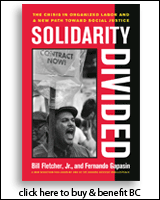
|
 |
 |
 |
| |
| |




















